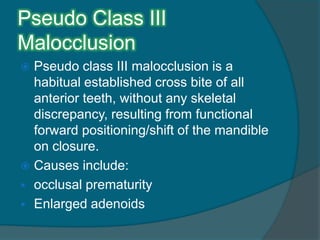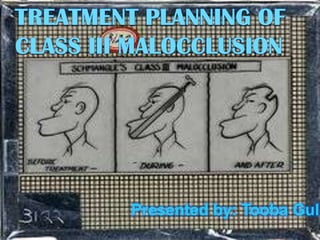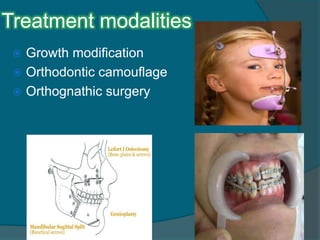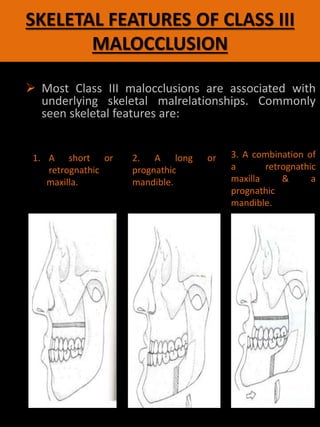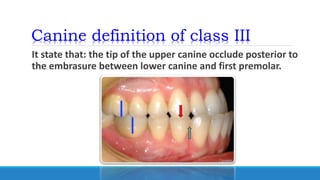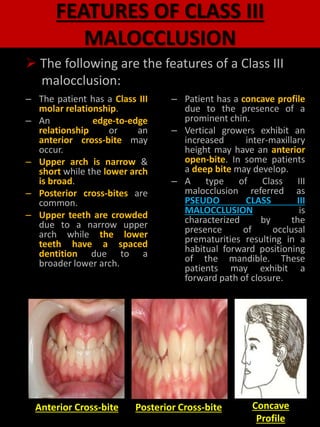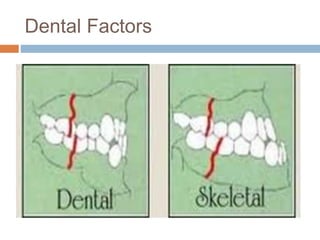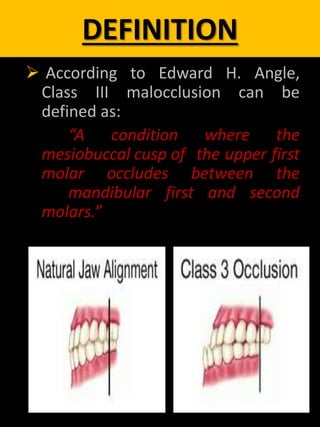class iii malocclusion slideshare
However adult patients with an anterior crossbite should still check for functional shift CO-CR discrepancy during clinical. -Class III incisor.
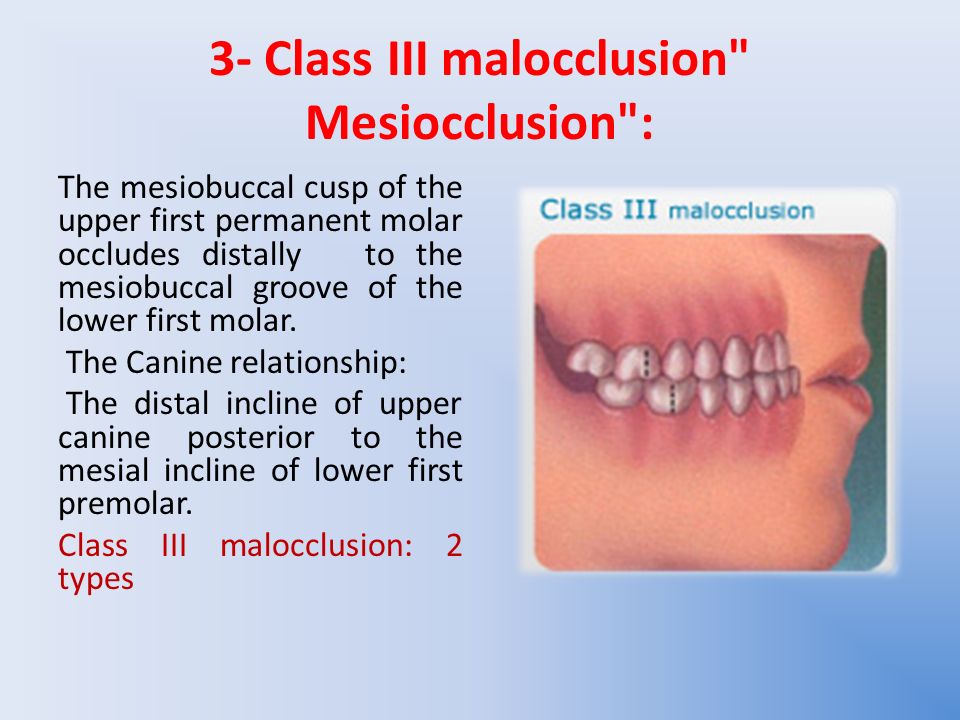
Orthodontic Dr Enas Talb 4th Class Ppt Video Online Download
Lateral cephalograms of 302 adult patients who had a class III molar and cuspid relationship were traced.
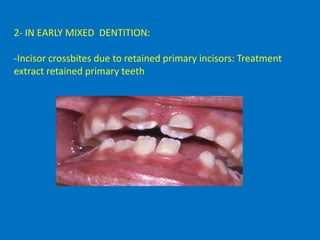
. This type of malocclusion is a growth-related problem that often becomes severe if. Is there an ideal time to treat a developing class III maloc-clusionJust a few studies have examined the e ectofageon maxillary protraction therapy. It is where an anterior displacement masking an underlying sk class I base.
The etiology of Class III malocclusion is multifactorial with genetic ethnic environmental and habitual components. Clinically Class III malocclusion is in two forms. CLASS III MALOCCLUSION Presented by.
Surgical treatment of Class III malocclusion includes in most cases mandibular retrusion maxillary protrusion or a combination of both. Position of the mandible. Is when the lower incisor edge lies anterior to the cingulum plateau of the upper incisors.
50 Generally as growth is completed there is little or no functional shift of the mandible on closure. Anterior crossbite with functional shift also called pseudo Class III is a malocclusion in which the incisal edges of one or more maxillary incisors occlude with the incisal edges of the mandibular incisors in centric relationship. CONTENT INTRODUCTION CLASSIFICATION ETIOLOGY CLINICAL FEATURES DIAGNOSIS TREATMENT 3 3.
Its also known as postural class III. Skeletal Class III malocclusion can be classified into retruded maxilla protruded mandible or a combination of the two according to cephalometric analysis. Learn new and interesting things.
The maxilla and the correction of the class III malocclusion. In the early mixed dentition and in older patients with mild skeletal. Dentoskeletal Class III malocclusions are one of the greatest challenges to the orthodontists due to the interaction of both environmental and genetic etiological factors.
Class III malocclusion seminar 1. CLASS III SUB-DIVISION Condition in which class III molar relationship is present only on one side with normal relation on the other side. Mandibular alveolus and the vertical development of the face.
Skeletal class II and III malocclusions are disorders with a sagittal discrepancy between the maxilla and the mandible 2 3. 1 The reported incidence of this malocclusion ranges between 1 to 19 with the lowest among the Caucasian populations 23 and the highest among the Asian populations. Among the environmental factors involved we can mention oral habits hypertrophy of tonsils or adenoids.
The center of the lower first molar mesiobuccal groove is anterior to. Forward movement of the mandible during jaw closure can also result from premature loss of deciduous posterior teeth. Khushbu Agrawal Guided by.
Class III A class III intermaxillary relationship means that the lower teeth are shifted forward with regard to the upper teeth. Mandibular clockwise rotation can also provide the same result as mandibular retrusion when increase. View Class 3 Malocclusion PPTs online safely and virus-free.
Prevalence of class III malocclusion in Caucasians ranges from 08 to 40 and rises up to 1213 in Chinese and Japanese populations while in North Indian population class III malocclusion is found in up to 34 of the population. VTs GROWTH IN PATIENTS WITH CLASS IIIGROWTH IN PATIENTS WITH CLASS III MALOCCLUSIONSMALOCCLUSIONS The craniofacial skeletal pattern of children with ClassThe craniofacial skeletal pattern of children with Class III malocclusion is evident in the early deciduousIII malocclusion is evident in the early deciduous dentitiondentition. Prognathism is considered a malformation of eminently genetic causes although its etiology is still multifactorialThus a combination of inheritance and environment can enhance or decrease malocclusion.
Malocclusion is the term for a skewed relationship between the positioning of the teeth with the jaw closed. A pseudo or functional Class III due to an early interference with the muscular reflex of mandibular closure and b the true Class III. The Position of the maxilla.
Class II malocclusion. Examined Japanese female patients with class III malocclusion divided. 3-5 UK -IN ASIAN POPULATION.
The National Health and Nutrition Examination Survey reveals that a large percentage of the population has a malocclusionThat means that many people in the world have ill-positioned teeth. A sample of 69. In Class III malocclusion the overjet is reduced and may be reversed with one or more incisor teeth in lingual crossbite.
Class III molar relationship exists on one side. Class III malocclusion is considered to be one of the most difficult and complex orthodontic problems to treat. Get ideas for your own presentations.
Class 3 Malocclusion Treatment Options. Compared to class II and class I a true class III malocclusion is rare. The mandible and mandibular incisors are then guided anteriorly in central occlusion resulting in an anterior crossbite.
Class III malocclusions are the least common type of malocclusion yet they are often more complicated to treat and more likely to require orthognathic surgery for optimal correction. PSEUDO Class III malocclusion FALSE or postural which occurs when mandible shifts anteriorly during final stages of closure due to premature contact of incisors or the canines. A developing skeletal class III malocclusion is one of the most challenging problems confronting the practicing ortho-dontists 13.
The embrasure between the lower canine and the lower first premolar is shifted forward with regard to the upper canine blue arrows. Share yours for free. 10 IN CHILDREN 4.
Over the years several interceptive treatments for Class III dentoskeletal malocclusions have been proposed in growing patients. The American Veterinary Dental College defines Class II malocclusion as mandibular distocclusion when there is an abnormal rostro-caudal relationship between the dental arches in which the mandibular arch occludes caudal to its normal position relative to the maxillary arch Figure 3Terms that have commonly been associated with class II. The following five sets of measures were analyzed.
Pseudo Class III Malocclusion Pseudo class III malocclusion is a habitual established cross bite of all anterior teeth without any skeletal discrepancy resulting from functional forward positioningshift of the mandible on closure. CAUSES OF PROGNATISM OR CLASS III AND HOW TO DETECT IT. PSEUDO CLASS III MALOCCLUSION Due to occlusal prematurity when the mandible moves from rest position to occlusion it slides forward into a pseudo class III position.
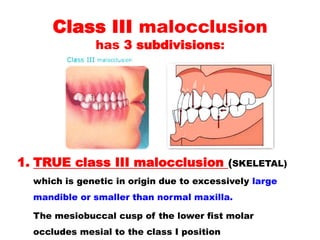
8 Setting Of Teeth For Class I Ii And Ii Arch Relation Ship Edit

Classification Of Orthodontic Malocclusion Ppt Download
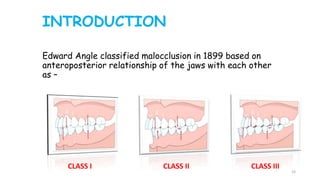
Management Of Class Ii And Iii Malocclusion
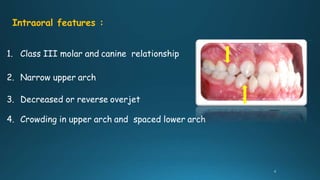
Treatment Of Class Iii Malocclusion

Class Iii Malocclusion Ppt Download
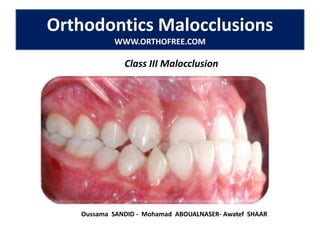
100 Malocclusions Common Orthodontic Problem Mohamad Aboualnaser Awat
